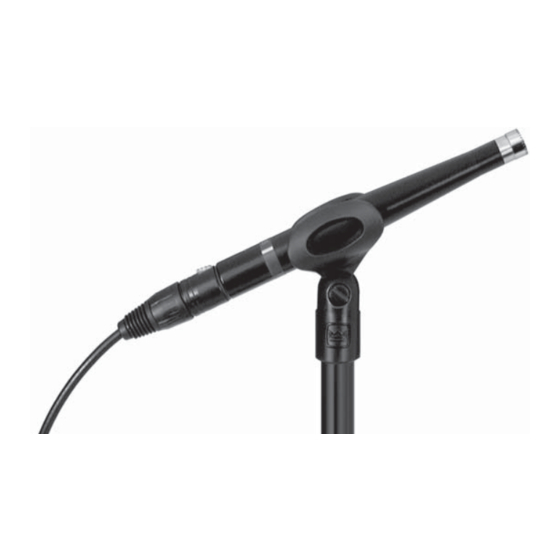
Crown CM-150 Brochure & Specs
Professional omnidirectional condenser microphone
Hide thumbs
Also See for CM-150:
- Application manual (11 pages) ,
- Application manual (14 pages) ,
- Application manual (8 pages)
Advertisement
Quick Links
CM-150
T
he CM-150 is a ½-inch-diameter
(12.7-mm), omnidirectional electret-
condenser microphone. It is intended
for professional recording, free-field mea-
surement and sound-level measurement.
Because of its pre-aged titanium diaphragm,
the CM-150 is extremely stable over a wide
range of environmental conditions.
The CM-150 has a very flat, wide-range fre-
quency response. The mic is supplied with a
proof-of-performance sheet, which shows
frequency response and sensitivity. This
information can be used to calibrate the mi-
crophone. The mic capsule grille fits into a
Bruel & Kjaer 4220 pistonphone or similar
microphone calibrator.
When used for recording, the CM-150
sounds natural and accurate. It preserves
the delicate timbre of acoustic instruments,
yet can reproduce all the power of a pipe
organ. The off-axis response is also smooth,
so any leakage picked up has little colora-
tion.
Self-noise is low, permitting clean record-
ings — especially with close miking. The
mic can handle very loud sounds (127 dB
SPL) without distortion. It is protected
against static and RFI. The output is bal-
anced, low impedance, which allows long
cable runs without hum pickup or high-fre-
quency loss. Powering is by 18-48 volt
phantom power.
An included foam windscreen reduces wind
noise outdoors.
Architects' and Engineers' Specifications
The microphone shall be a Crown CM-150
or equivalent. It shall be an omnidirectional
electret-condenser type powered by 18-48
volt phantom power. Frequency response
shall be uniform from 20 Hz to 20,000 Hz.
Open-circuit sensitivity shall be 10.5 mV/Pa.
Maximum SPL for 3% THD shall be 127 dB
with 48-volt phantom power. Self-noise shall
be 19 dB SPL A-weighted. Impedance shall
be 240 ohms balanced. The mic shall be
compatible with ½-inch (12.7 mm) indus-
try standard calibration. The Crown CM-
150 is specified.
PROFESSIONAL OMNIDIRECTIONAL
CONDENSER MICROPHONE
Specifications
Element: Electret condenser.
Frequency response (typical): 20 Hz to 20 kHz
±1.5 dB (see Fig. 1).
Polar pattern: Omnidirectional (see Fig. 2)
Impedance: 150 ohms, 240 ohms actual, bal-
anced. Recommended minimum load imped-
ance 1000 ohms.
Open circuit sensitivity (48 volt supply): 10.5
mV/Pa* (–39.5 dB re 1 volt/Pa) nominal.
Power sensitivity: –39.5 dB re 1 mW/Pa.
Equivalent noise level (self-noise): 19 dB SPL
typical, A-weighted (0 dB = .0002 dyne/cm
S/N ratio: 75 dB at 94 dB SPL.
Maximum SPL for 3% THD: 127 dB with 48V
phantom power.
Output connector: 3-pin male XLR type.
Power: 18-48 volt phantom power, positive volt-
age on pins 2 and 3 with respect to pin 1.
Current drain: 2.7 mA.
Polarity: Positive (inward) pressure on the dia-
phragm produces positive voltage on pin 2 with
respect to pin 3 of the output connector.
Materials: Brass handle, stainless steel mic cap-
sule, titanium diaphragm.
Finish: Satin black handle and chrome mic cap-
sule.
Dimensions: See Fig. 3.
Weight: 4.48 ounces (127 grams).
Included accessories: WS-15 foam wind-screen,
carrying pouch, ASA-4 stand adapter and vinyl
grille protector.
Optional accessories: Crown PH-4B phantom
power supply (4 channels, AC powered). Crown
PH-1A phantom power supply (1 channel, bat-
tery or AC powered).
2
*1 pascal = 10 dynes/cm
= 10 microbars = 94 dB
SPL.
Fig. 1
Frequency Response
Frequency in Hz
2
).
Fig. 2
330˚
FRONT
300˚
270˚
240˚
REAR
210˚
180˚
0˚
30˚
-0
60˚
-5
-10
-15
-20
90˚
120˚
OMNI 20 Hz-2 kHz
5 kHz
10 kHz
20 kHz
150˚
Advertisement

Subscribe to Our Youtube Channel
Summary of Contents for Crown CM-150
- Page 1 Because of its pre-aged titanium diaphragm, the CM-150 is extremely stable over a wide range of environmental conditions. The CM-150 has a very flat, wide-range fre- quency response. The mic is supplied with a proof-of-performance sheet, which shows frequency response and sensitivity.
- Page 2 .500" dia. (1.27 cm. dia.) Sensitivity Changes vs. Phantom-Power Voltage The CM-150 has different sensitivity at different phantom voltages. If you use phantom powering other than 48 volt, change the printed sensitivity of your unit by the amount shown in the right hand column below.













Need help?
Do you have a question about the CM-150 and is the answer not in the manual?
Questions and answers